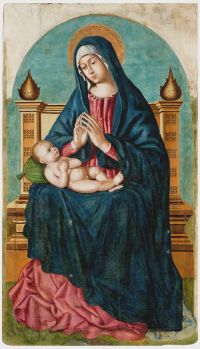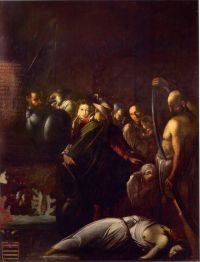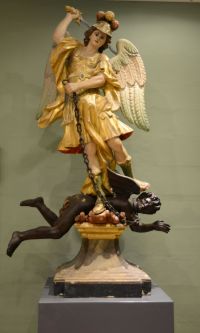Explore

Showcase – Archaeology in Zejtun
The exhibits come from a Punic-Roman tomb discovered accidentally in 1963 by a farmer in a field to the East of the Girls Secondary School (Kulleġġ Santa Margerita) in Zejtun, close to the remains of a Roman Villa. The interior of the tomb consisted of a vertical shaft and a horizontal chamber dug out in the rock in Punic period. The underground tomb was used about five times, at least once towards the end of the Punic period (c. 500-218 BC) [upper shelf], and several times again in the Roman period (218 BC-AD 535) [lower shelf]. Egg-shaped amphora on bottom shelf belongs to the first period; the larger amphora with a cut-out section belongs to the second period.
Enthroned Madonna and Child, Att. Antonio de Saliba
The recent restoration of the panel painting of the Enthroned Virgin and Child had revealed the original work of Antonio de Saliba after being over-painted by the Spanish Baroque artist Pedro Nunez de Villavicencio in 1672. Saliba’s panel painting originally belonged to a triptych composed of two lateral wings depicting St. Paul and St. Catherine of Alexandria, and probably was meant to be placed on the high altar of the old parish church of Żejtun, now commonly known as St. Gregory’s. The first comment made on the painting may be obtained from the 1693 pastoral visitation report of Fra Davide Cocco Palmiere, in which he notes that the panel had been recently restored by ‘Fra Pietro Villavicente’. The panel remained at st. Gregory’s until its translocation in 1709, when the transepts of the new parish church had practically reached completion. The panel painting now resides on the altar dedicated to the Virgin of the Rosary in the south transept of the parish church. It is a work of utmost importance to the repertoire of Maltese works belonging to the Southern Italian and Sicilian Early Renaissance artistic tradition of the late fifteenth- and early sixteenth-century. It is indeed an exemplary work of art for it clearly reflects the quality and style developed by Antonello da Messina, whose ideas were channelled to Malta through artists such as Antonio de Saliba- an artist who was not only his relative, but was also, actively involved in his workshop.
Showcase – Liturgical Silverware
Every old church through the years collects a large quantity of liurgical articles and furnishings. In our case some of the exhibits coming from the old parish church evidence the economic situation of 17th century Zejtun, even though the reliquary attests that donations by some important families were made to the church. From the 18th century onwards the collection of silverware becomes richer in quantity and quality.
Martyrdom of St Catherine of Alexandria, Follower of Caravaggio
The painting of The Beheading of St Catherine is the work of an artist very close to Caravaggio. We do not know whether the picture was designed by Caravaggio himself with a different subject, discarded and another artist familiar with Caravaggio changed the subject and completed the painting himself. This canvas boasts several artistic and historical elements that make it today the object of special international attention.
Showcase – Liturgical Vestments
From a large collection of liturgical vestments, some of which are still in use, only two old chasubles dating back to the early 18th century that were used in the old parish church of Saint Catherine are presently exhibited. Under the two chasubles the linen albs decorated with fine, intricate locally manufactured lace complete the set. During the liturgical celebration of the patron saint of Zejtun, Saint Catherine of Alexandria, a large set of chasubles, dalmatiche and copes in red velvet with gold embroidering are put on show.
The Baptism of Christ, after Alessandro Algardi
The mid-seventeenth century small bronze-gilt sculptural group representing the baptism of Christ is attributed to the Italian Baroque sculptor, Alessandro Algardi. It should be noted that there are many models of this three-figure sculpture since it could repeatedly be cast in bronze. However, the one at Żejtun is one of five models attributed directly to Algardi. The small model characterises what is understood by Baroque Classicism, in its straightforward composition, arrested motion or affetti and lack of over-empowering dynamic movements and drapery folds, in contrast to the contemporaneous trend of Bernini’s Baroque. The Baptism of Christ group, thus, belongs a series of other mall models such as the Corsini Flagellation group which embodies similar characteristics. The baptism of Christ model furthermore, is clearly used as the design on which Mazzuoli based his the composition of the large titular sculptural group of the Baptism of Christ for the Co-Cathedral, Valletta. Although not exclusively, due to his influential Maltese contemporary – Melchiorre Cafa, Algardi’s model, nonetheless, exemplifies the sculptural artistic tradition that prevailed both in Malta and particularly, in Rome, during the mid-seventeenth century, and is of a high-enough qaulity to form part of the national collection.
St Michael the Archangel, Anon
The wooden statue of St Michael reflects the cultured taste which parish priests and rectors of churches had during the 18th century in Malta. This work shows in its articulation and polychromy not only a Spanish influence but perhaps its real provenance.
St Joseph, Anon
This wooden statue of St Joseph holding the baby Jesus was for many years in the old parish church of St Catherine (Zejtun). Its great artistic value depends on the original polychromy and the estofado technique. Still unknown how it reached Zejtun but its Spanish style and the commercial links which parishoners had with the Iberian peninsula during the 18th century reveal some elements of this mystery.
Christ after the Flagellation, Spanish Artist
Formerly standing on one of the altars in the old church of Our Saviour (Zejtun), this small wooden sculpture representing Christ after the Flagellation is unique because of its provenance. From various elements found on the statues, i.e the tears made of glass and the eye lashes of natural hair, all indicate that this is of Spanish origin. In Spanish art this subject was already tackled by important artists such as Esteban Murillo. In1665 Murillo painted the same subject, (today in the Museum of Fine Arts, Boston) and he focuses exclusively on Christ’s suffering, choosing a moment after his tormentors have left the scene. The artist has placed him humbly upon the ground and painted his battered body so that his skin seems almost radiant, despite its wounds and sores. The angels display both adoration and compassion for the tortured Christ, the emotions the image was intended to arouse in its viewers. Murillo was known for his intense renderings of religious martyrdom and ecstasy and for the sensuous beauty of his paint. In this staute which dates back to the 18th century and still retains its original polychromy, the artist re-interprets Murillo’s ideas in a very faithful and realistic manner.
Christ at the Column, Alessandro Farrugia
Alessandro (Xandru) Farrugia (1791-1871) was born in Zejtun and attended the workshop of master sculptor Marjanu Gerada (1771-1823). The latter had for some years studied and worked in Valencia with important Spanish artists and on his return from Spain managed a very crowded workshop. Farrugia absorbed most of the master’s ideas and these are strongly reflected in the Christ at the column of 1845. Spanish baroque sculptors during the 17th century (e.g. Gregorio Fernández (1576-1636), had produced similar works and became important prototypes. Farrugia’s dynamic contrapposto, anatomy and the treatment of the drapery folds in this statue show the intensity with which he had absorbed the Spanish lesson.
The Dead Christ – Lying in State
The figure of the Dead Christ was brought from Spain, while the decorated large urn was manufactured some time before World War II to replace an earlier more simple urn. The four small angels in papier-mache’ holding the symbols of the Passion were made by Wistin Camilleri, a local artist. The intricate and fine gold weaving on the dark red velvet covering the top part and the base of the urn was all done by the Zejtun Nuns of the Insitute of Jesus of Nazareth.
The Ark of the Covenant
There are various renderings of the Jewish Ark of the Covenant. This is set on Egyptian symbolism while its measurements correspond faithfully to those indicated in the Bible. Sculpted in wood and gold gilded, the Ark of the Covenant is one of the showpieces that decorate the long and articulated procession of Good Friday in Zejtun.
 Malti
Malti English
English















